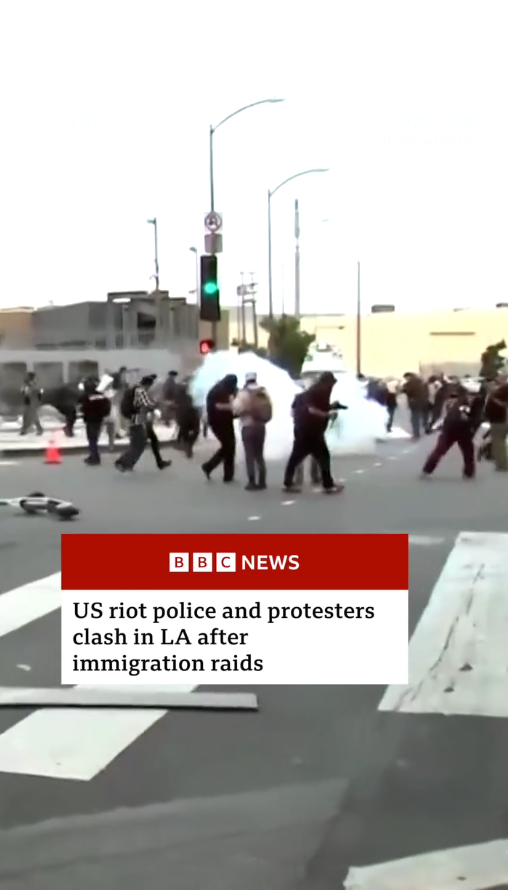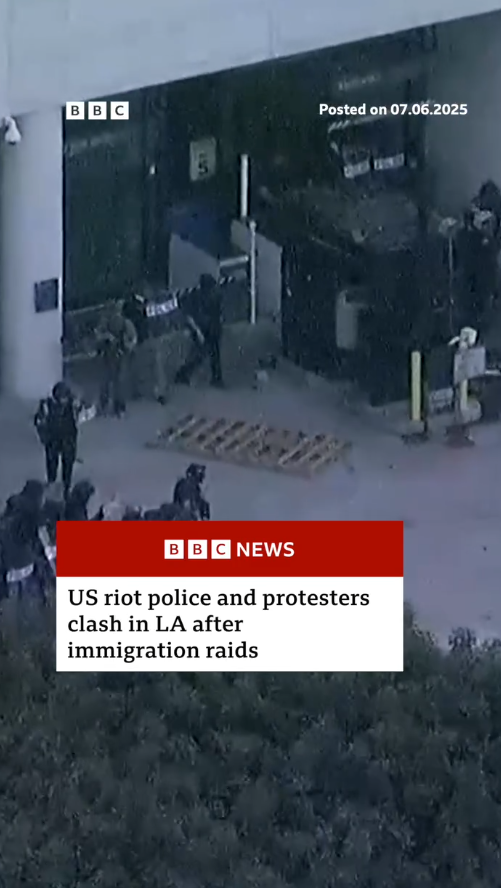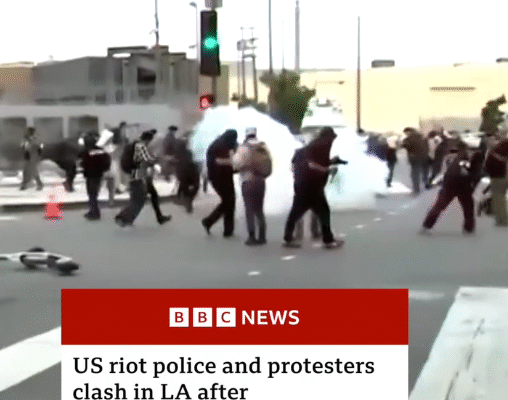
Tension reached a boiling point in downtown Los Angeles this week as riot police and protesters clashed following a series of aggressive immigration raids conducted by federal agents. What began as a peaceful protest quickly escalated into chaos, with demonstrators demanding justice and an end to what they describe as inhumane and discriminatory enforcement practices.
The raids, which reportedly targeted multiple neighborhoods across Los Angeles County, resulted in the detention of dozens of undocumented immigrants. According to eyewitness accounts and civil rights organizations, many of those detained had lived in the area for years and had no prior criminal records. The abrupt and forceful nature of the operations sparked immediate outrage, with community leaders and advocacy groups accusing federal authorities of tearing families apart and instilling fear in immigrant communities.
The Build-Up to Unrest
Reports of Immigration and Customs Enforcement (ICE) agents conducting early morning raids began circulating on social media early Tuesday. Videos showed agents in tactical gear surrounding apartment buildings and stopping cars in what many described as random checkpoints. By midday, community organizers had mobilized a response, calling for a peaceful demonstration outside Los Angeles City Hall to demand answers and accountability.
By 4 p.m., thousands of protesters had gathered downtown. Many carried signs reading “No Human is Illegal,” “Stop the Raids,” and “Families Belong Together.” The demonstration was initially peaceful, with speeches from local leaders, chants in English and Spanish, and visible support from various religious, student, and immigrant rights groups.
Escalation Into Violence

As the sun set, the atmosphere began to shift. Tensions rose when a line of riot police in full protective gear formed a barricade near a government building adjacent to the protest site. Protesters claimed the police presence was unnecessarily aggressive and provoked anxiety in a crowd that included families and children.
Shortly after 7 p.m., confrontation broke out. Protesters attempted to block a nearby street, and some individuals reportedly began throwing water bottles and debris. In response, police declared the protest an unlawful assembly and began to disperse the crowd using tear gas and rubber bullets. Videos from the scene show smoke filling the streets, protesters running for cover, and others linking arms in defiance.
The Los Angeles Police Department later reported that multiple officers were injured during the altercation, although none seriously. Dozens of protesters were arrested on charges ranging from disorderly conduct to assaulting an officer.
Community Reaction

The events have ignited an outpouring of emotion from Angelenos, many of whom see the protests as a reflection of deeper issues surrounding immigration, policing, and human rights in the city.
Maria Lopez, a DACA recipient and student at Cal State LA, was at the protest and recounted her experience:
“We were peaceful. We were grieving. These raids didn’t just arrest people—they shattered entire communities. And then the police met us with shields and batons. How can they not see we’re just trying to protect our families?”
Local lawmakers have also weighed in. City Councilmember Hugo Soto-Martínez, a longtime labor organizer and immigration advocate, issued a statement condemning both the raids and the police response to the protest.
“What happened in downtown Los Angeles is a stain on our city. We must protect our residents from cruel and arbitrary immigration enforcement. We must also ensure that those who exercise their right to protest are not met with violence,” he said.
However, law enforcement officials defended their actions, stating that their primary goal was to maintain public safety.
“Our officers responded to a situation that was escalating rapidly,” said LAPD Deputy Chief Veronica Alvarez. “We understand the sensitivity of the issue at hand, but we cannot tolerate unlawful behavior that puts others at risk.”
Federal and Political Implications
The raids and subsequent protests have drawn national attention, reigniting debate over immigration policy in the United States. Critics of current enforcement practices argue that sweeping raids disproportionately target low-income communities and create lasting psychological trauma.
Advocacy groups like the ACLU and CHIRLA (Coalition for Humane Immigrant Rights) have called for an immediate halt to the raids and the release of those detained. They also demand an independent investigation into the police response at the protest.
The Biden administration, which has faced criticism from both immigration hardliners and reform advocates, has not yet issued an official response. However, Democratic members of Congress representing Los Angeles, including Rep. Jimmy Gomez and Rep. Nanette Barragán, have called for a federal review of the incidents and greater oversight of ICE operations.
A City on Edge
The situation in Los Angeles remains tense. Protesters have vowed to return to the streets in the coming days, and a citywide vigil is being planned to honor those affected by the raids. In many neighborhoods, fear lingers—not only of federal agents but also of how dissent might be treated.
Community organizers are urging calm but remain firm in their stance.
“We are not going to stop until our communities are treated with dignity,” said Ana Gutierrez of Immigrant Justice LA. “What happened this week is a symptom of a broken system. But we are stronger than fear.”
As Los Angeles grapples with the fallout, the city stands at a crossroads. The clash between police and protesters after the immigration raids isn’t just about one night of unrest—it’s about a city, and a nation, deciding what kind of justice it truly believes in.



